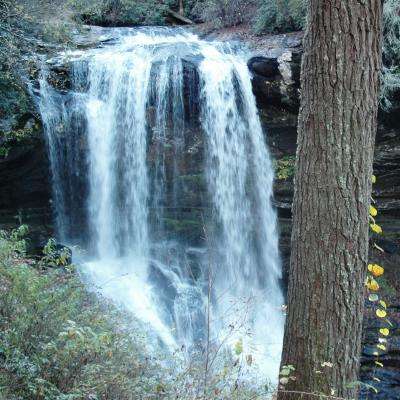Evidence of geological 'facelift' in the Appalachians

How does a mountain range maintain its youthful, rugged appearance after 200 million years without tectonic activity? Try a geological facelift – courtesy of the earth's mantle.
Researchers from North Carolina State University noticed that a portion of the Appalachian Mountains in western North Carolina near the Cullasaja River basin was topographically quite different from its surroundings. They found two distinct landscapes in the basin: an upper portion with gentle, rounded hills, where the average distance from valley to mountain top was about 500 feet; and a lower portion where the valley bottom to ridgeline elevation difference was 2,500 feet, hills were steep, and there was an abundance of waterfalls. The researchers believed they could use this unique topography to decipher the more recent geologic history of the region.
The Appalachian mountain range was formed between 325 to 260 million years ago by tectonic activity – when tectonic plates underneath the earth's surface collided and pushed the mountains up. Around 230 million years ago, the Atlantic Ocean basin began to open, and this also affected the regional topography. But geologists knew that there hadn't been any significant tectonic activity in the region since then.
"Conventional wisdom holds that in the absence of tectonic activity, mountainous terrain gets eroded and beveled down, so the terrain isn't as dramatic," says Sean Gallen, NC State graduate student in marine, earth and atmospheric sciences. "When we noticed that this area looked more like younger mountain ranges instead of the older, rounded, rolling topography around it, we wanted to figure out what was going on."
Gallen and Karl Wegmann, an assistant professor of marine, earth and atmospheric sciences at NC State, decided to look at the waterfalls in the area, because they would have formed as the topography changed. By measuring the rate of erosion for the falls they could extrapolate their age, and therefore calculate how long ago this particular region was "rejuvenated" or lifted up. They found that these particular waterfalls were about 8 million years old, which indicated that the landscape must have been raised up around the same time.
But without tectonic activity, how did the uplift occur? Gallen and Wegmann point to the earth's mantle as the most likely culprit. "The earth's outer shell is the crust, but the next layer down – the mantle – is essentially a very viscous fluid," Wegmann says. "When it's warm it can well up, pushing the crust up like a big blister. If a heavy portion of the crust underneath the Appalachians 'broke off,' so to speak, this area floated upward on top of the blister. In this case, our best hypothesis is that mantle dynamics rejuvenated the landscape."
The researchers' findings appear in Geological Society of America Today. Del Bohnenstiehl, NC State associate professor of marine, earth and atmospheric sciences, contributed to the work.
More information: "Miocene rejuvenation of topographic relief in the southern Appalachians", Sean F. Gallen, Karl W. Wegmann, and DelWayne R. Bohnenstiehl, Dept. of Marine, Earth, and Atmospheric Sciences, North Carolina State University, 2800 Faucette Drive, Raleigh, North Carolina 27695, USA. Pages 4-10; doi: 10.1130/GSATG163A.1
Provided by North Carolina State University



















